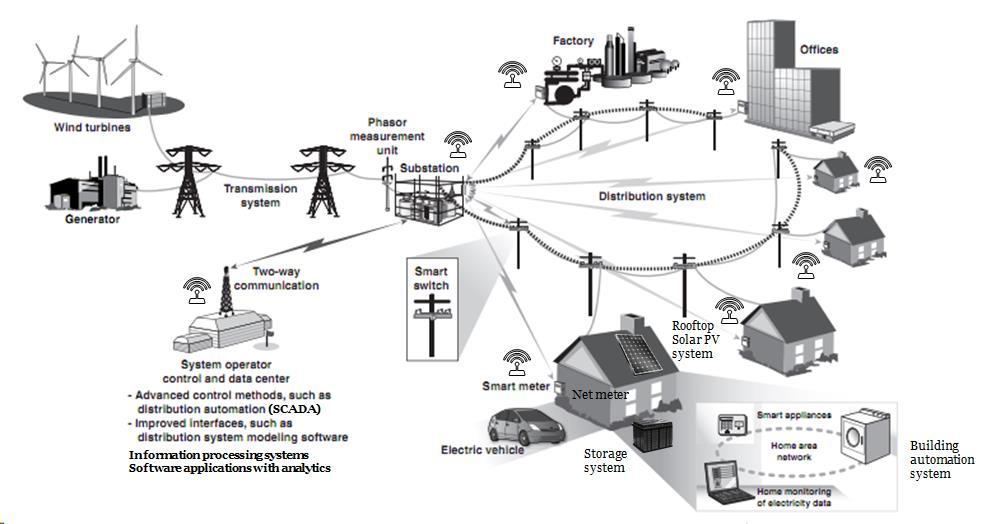
4 minute read
1. Introduction to DSM applications of smart grid technologies
Smart grid is an intelligent electrical grid that uses information and communication technologies (ICTs) to gather, monitor and act on real time (interval) information about power system characteristics (viz. generation, end use / load, price/tariff, performance of power system components etc) in an automated fashion to improve the efficiency, reliability, economics, and sustainability of the production, transmission, distribution and end use consumption of electricity.
Smart Grid Characteristics
Advertisement
Enabling active and informed participation by consumers (enhanced customer engagement)
Providing quality (interruption free and reliable) power for the digital economy
Accommodating all generation and storage options Enabling new products, services, and markets
Optimizing assets and operating efficiently Anticipate and respond to power system disturbances (SelfHealing) Operate resiliently against physical and cyber attack
Source: US DOE
Schematic of Smart Grid Infrastructure
Data provided by smart grid systems enable consumers to make informed decisions about how much, when and at what cost they use energy at various end use applications. This means the consumers gain enhanced information over end use energy in order to respond to price signals or other Utility incentives thereby increasing the overall capacity for DSM. Worldwide experience of adopting smart grid systems and technologies
has shown that they enable increased demand response1 , energy efficiency, integration of distributed variable renewable energy resources and electric vehicle recharging services, while reducing peak demand and stabilizing the electricity system.
DSM actions enabled by smart grid systems and technologies
Load shifting Peak clipping Valley filling
Strategic conservation
The smart grid systems and technologies that enable DSM can be grouped into three broad categories. Advanced Metering Infrastructure (AMI) is the principal smart grid system that constitutes smart meters, communication systems, computer based hardware (data storage centers / servers) and software applications to gather and act on real time information about end use energy in order to improve efficiency and economics of end use electricity consumption. Peak load management is the principal function of AMI among several other functionalities. AMI enables demand response by offering a variety of time based tariffs (e.g. time of day – TOD tariff, peak time rebate), demand bidding and direct load control programs2 during periods of peak demand in exchange for financial incentives and lower electric bills. Smart meters expand the range of time-based rate programs that can be offered to consumers along with robust communication of real time energy usage and pricing information that can make it easier for consumers to change their energy use behavior and reduce peak period consumption. AMI can help electric utilities and governments defer construction of new power system capacity (generation, transmission and distribution systems), specifically those reserved for use during peak times. Customer side systems3 such as smart appliances, in-home displays / energy dashboards and building automation are emerging smart grid technologies that enable enhanced (remote) control over the operations of home electrical appliances in order to shift / reduce energy usage in manner that promote efficiency and economics. These systems completely integrated with AMI further enhance the capacity of consumers and utilities to fully capture the potential of DSM.
Distributed renewable energy generation and storage integration systems such as net meters, grid tied / hybrid inverters, and smart charging systems are evolving smart grid technologies that enable seamless grid integration of energy storage devices, solar photovoltaic rooftop systems, electric vehicles and other distributed generation systems to take full advantage of their DSM potential.
1 Changes in electricity usage by end-use customers from their normal consumption patterns in response to time-based rates or other forms of financial incentives offered by electric Utilities. Methods of engaging customers in demand response efforts include offering time-based rates such as time-of-use pricing, critical peak pricing, variable peak pricing, real time pricing, and critical peak rebates. 2 More advanced demand response effort that enable utilities to cycle air conditioners, water heaters and other critical loads on and off during periods of peak demand in exchange for a financial incentive and lower electric bills. 3 It is important to note that there are several other customer side systems such as energy storage devices, solar photovoltaic rooftop systems, electric vehicles, energy efficient appliances (e.g. LED, BEE 5 star rated products, solar water heaters) and other distributed generation systems that can contribute to DSM and be perceived as smart grid systems and technologies, whose definition ultimately depends on the collective vision and goals of governments, utilities and consumers. This background paper does not discuss these smart grid technologies but instead aims to discuss the technologies that enable their seamless grid integration, which is crucial to realize DSM benefits of such technologies.
Smart grid systems and technologies
Advanced Metering Infrastructure (AMI)
Smart meters Communications technology and infrastructure Meter data acquisition and management systems (Data centers / servers / storage facilities, software applications / analytics)
Customer side systems
Smart appliances In house displays / energy dashboards Building automation
Integration of distributed renewable energy generation and storage systems
Net meters Grid tied and hybrid (dual function) inverters
DSM Applications
Demand response (time based tariffs, direct load control, demand bidding etc)
Energy efficiency (remote control of home appliances, LED lamps with motion sensors, inverter technology products etc)
Distributed generation and storage (energy storage devices, solar photovoltaic rooftop systems, electric vehicles)





